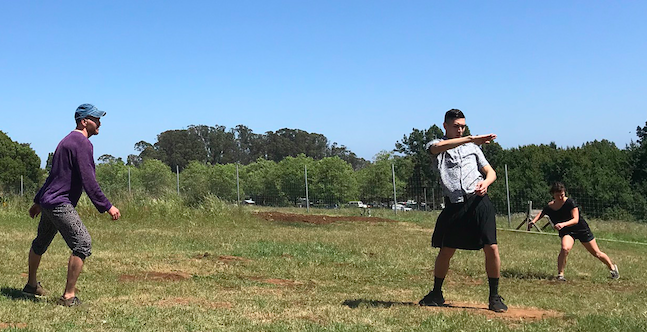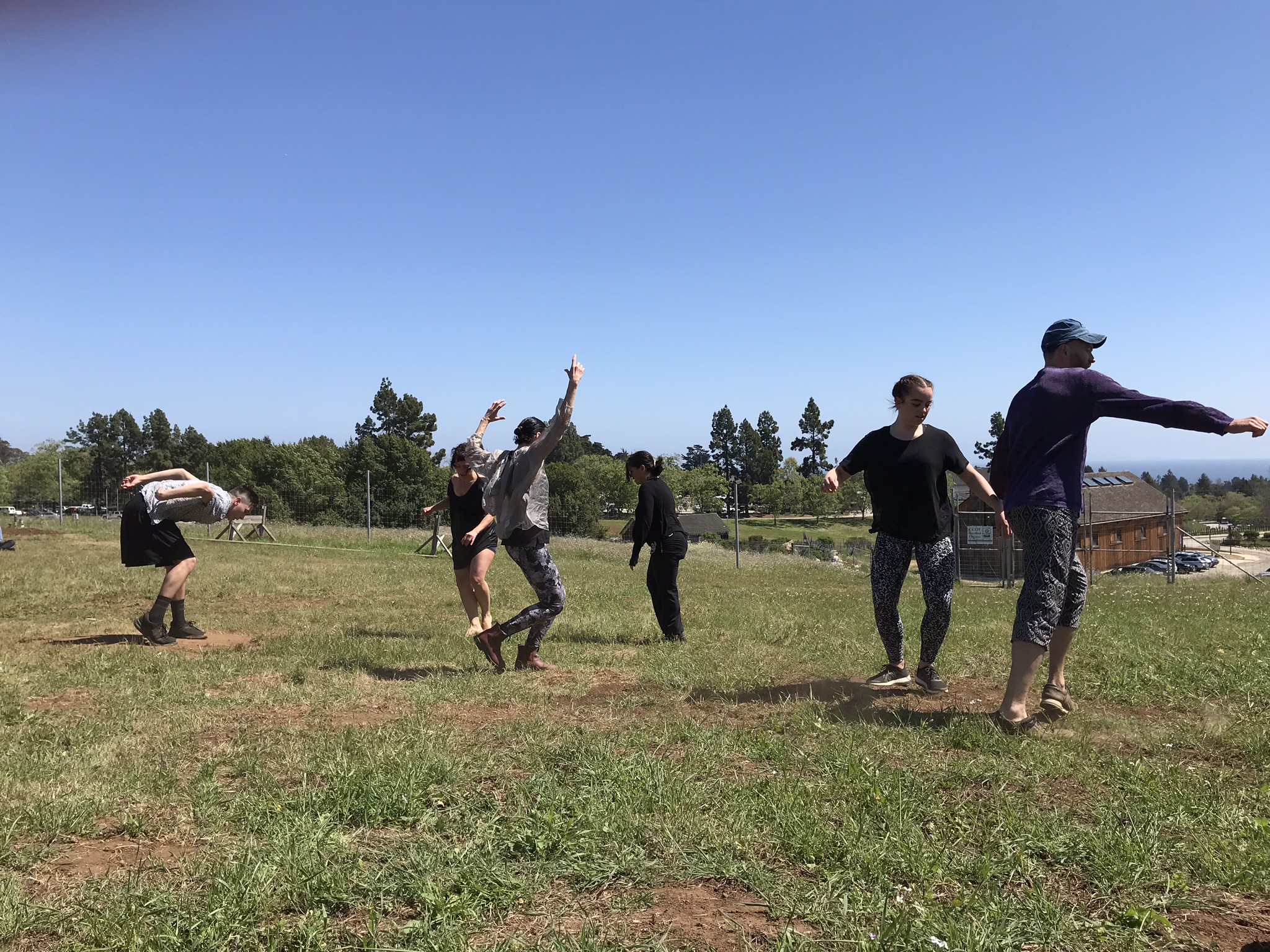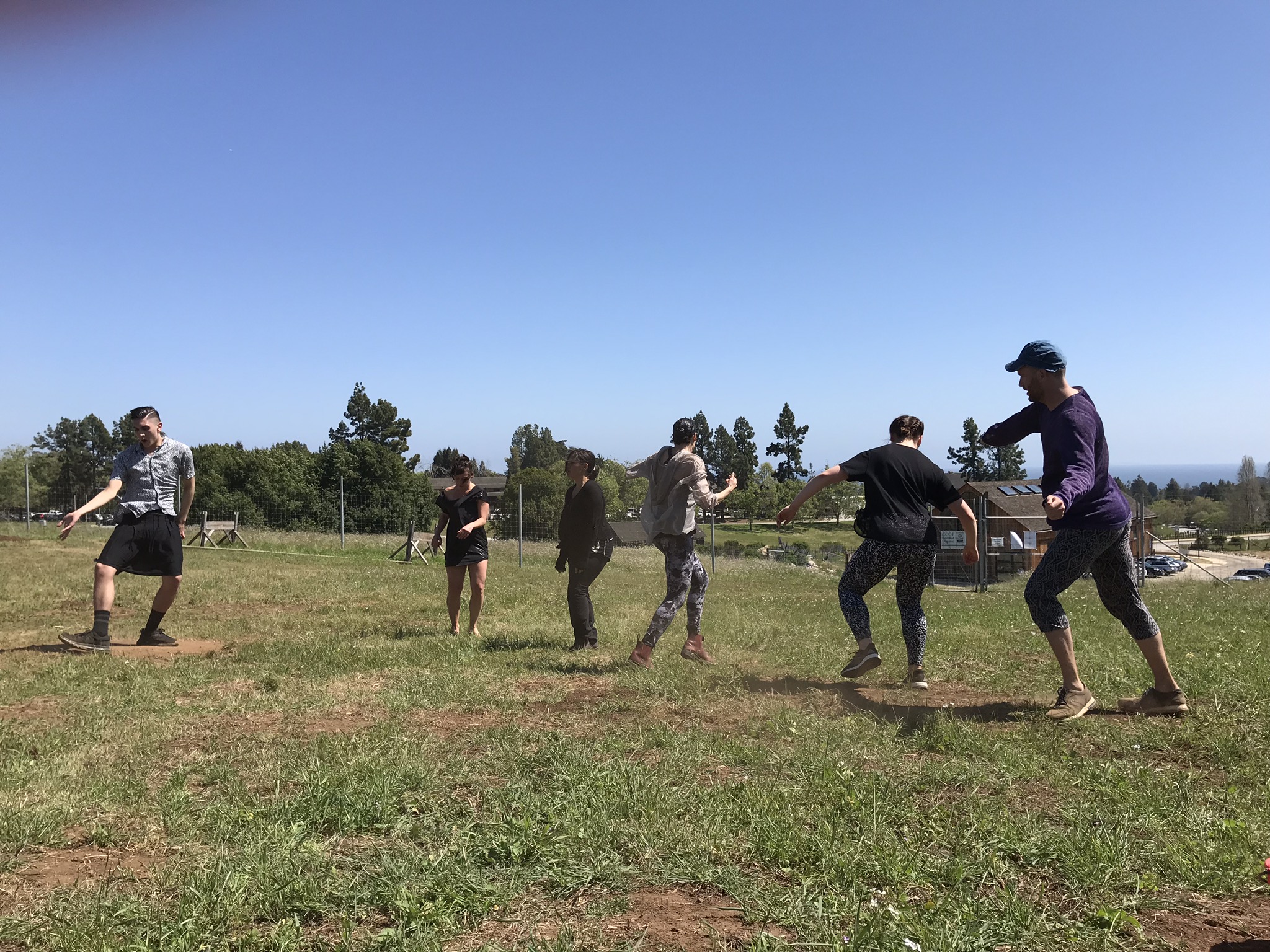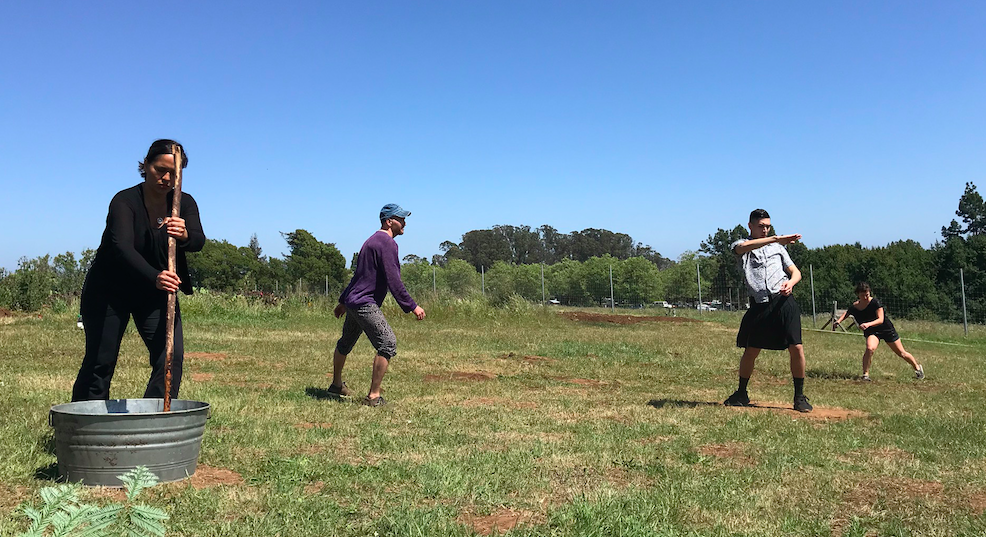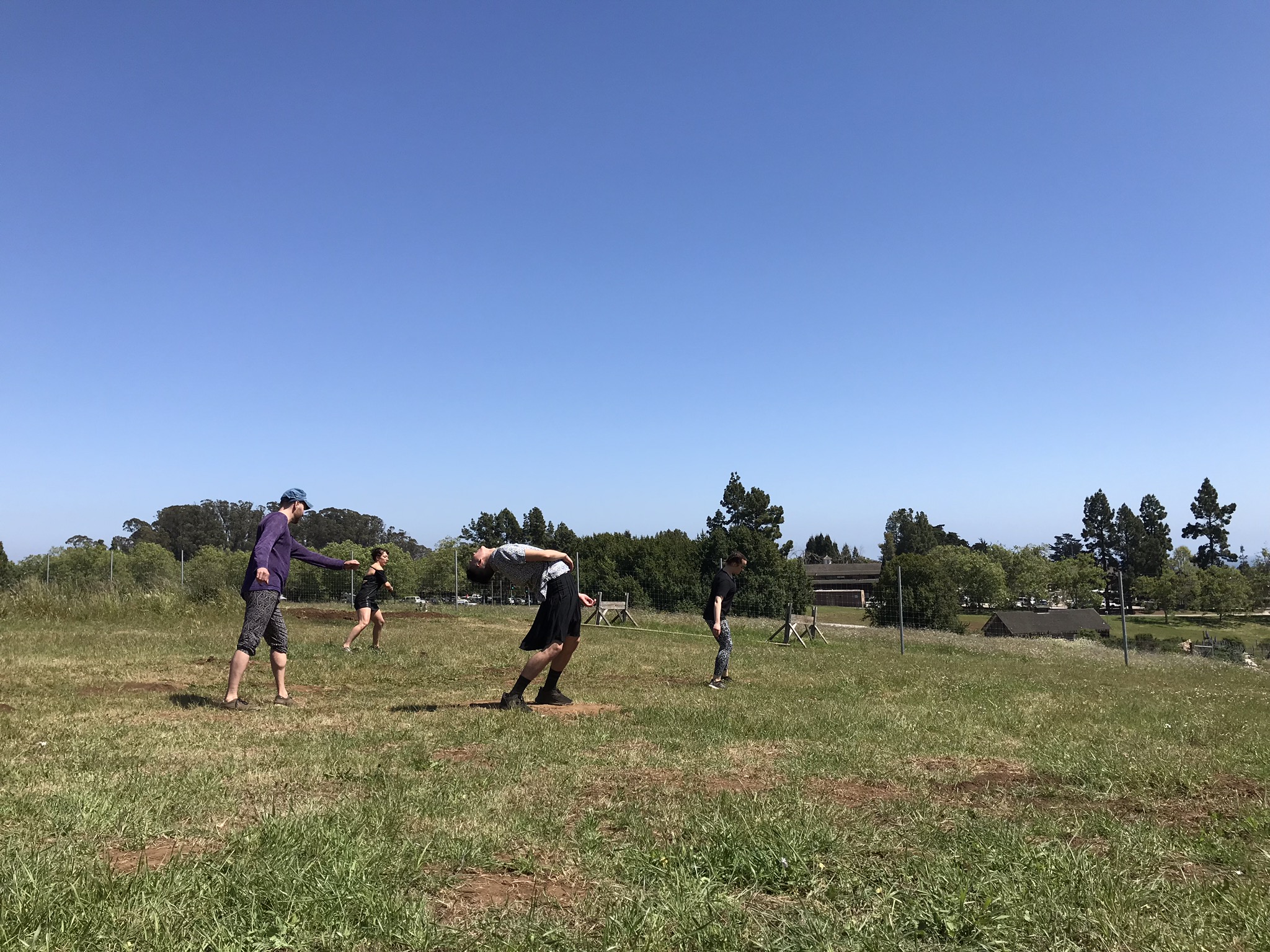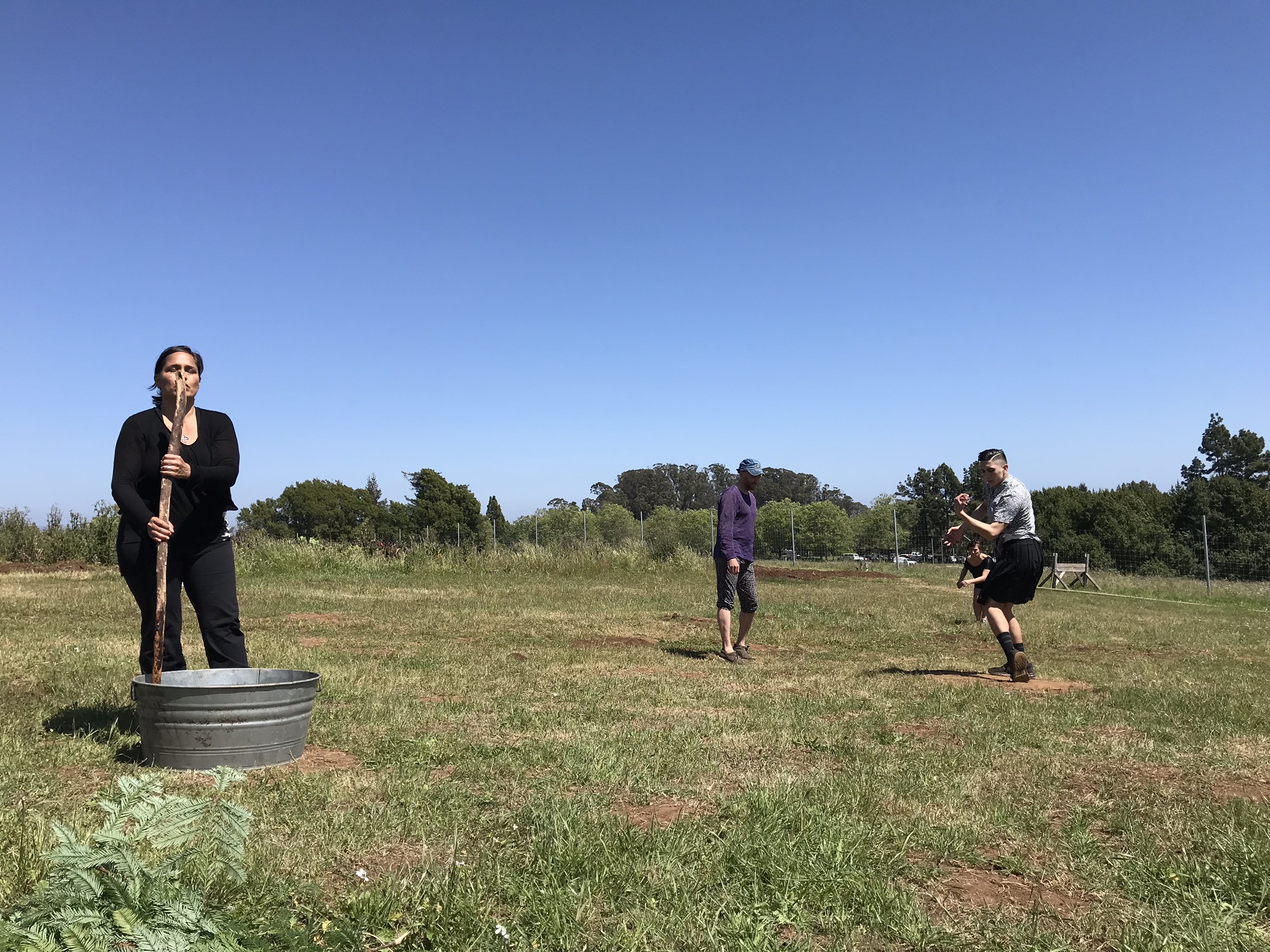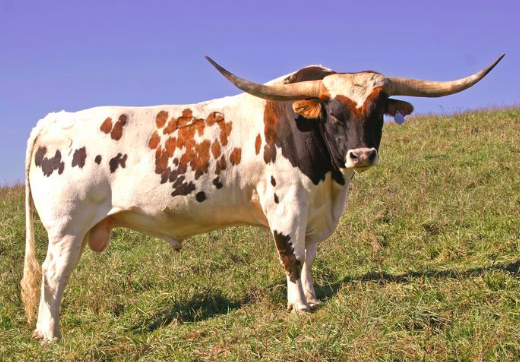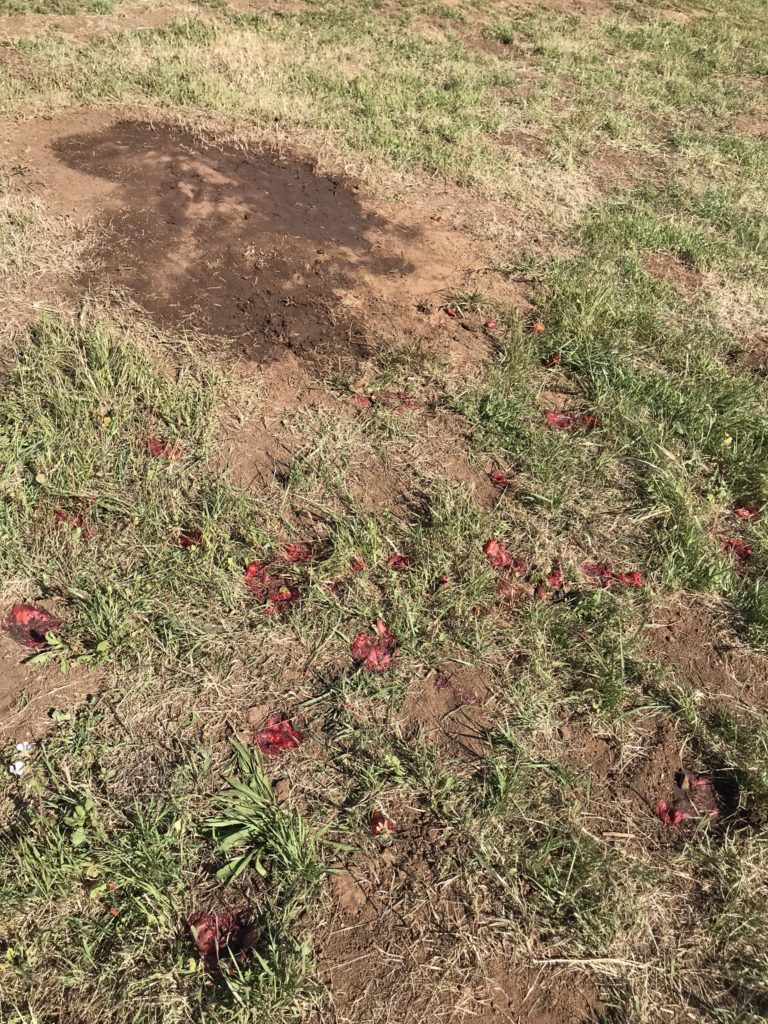We presented a work in progress showing of this piece at the Soil Symposium- Art and Science Meeting at the University of California Santa Cruz
Strange Stranger Collective:
Kevin O’Connor
Ruth Douthwright
Billy Jack
with:
Montana Summers
Dorit Osher
Avery Hall
Lori Halliday
Making Soil
Introduction:
We were performing a work in progress piece called Making Soil at the Seedbed Symposium in Santa Cruz, California. We are a collective of settler Canadians and Oneida Nation, artists from London, Ontario. We are thinking about other experiences of time and space possible for the relations between humans and soil alongside the dominant forms expressed by large-scale agriculture, and colonial practices within our hometown of London Ontario. The impetus for this piece occurred when one of our collective art-making partners, Billy suddenly died from cancer. Some of his cremated body was buried on the Oneida reserve where he was born and some in the local cemetery with his adoptive mom. Each space makes or enacts soil differently. This creative process and performance is a collective composing and recomposing of bodies, humans, microbes, soils and other forms, as we spread Billy’s ashes under our feet each time we do this dance. It is a kind of queer dying, inspired by Billy’s living. By becoming into death, we refer to a mode of dying that is an aspect of the transformation of being, an emerging into many other living and dying things much like the regenerative decay of decomposing leaves along the river we grew up alongside.
“soils” are produced through a complex set of cultural practices engaged in by real people, rather than simply being a bundle of natural determinations waiting for the expert’s successful unveiling.
Intro:Welcome
To our soil making practice,
some might call it a ritual, a performance, a funeral, a birth
a composing- recomposing and decomposing of multiple bodies- perhaps it could be read as a kind of compost heap
Ingredients:
1. PREP 500
The prep 500 recipe is as follows:
Collect corn horns
Fill them with fresh cow shit from lactating cow milk
Bury the horns in the ground in the fall and leave them over the winter- during this time the manure fermets and silica from the cow horn walls comes into relation with the cow dung (Star energy collected by the cow horns mixes with earth energy)
Unearth the horns in the spring
Step six stir the water for 45 minutes- (the turning energy activated the relations)-
The last step of this prepartation 500 is to stir it for 45 minutes before we spread it on the ground and the audience did this as they watched us
2. Prepare the land with “folk dances”
Tarentella (Sicily)- Kevin
Jewish Folk Dance – Ruth and Dorit
Smoke Dance (Oneida)- Montana
Line Dance (Avery had been taught growing up)
This creative process starts with learning dances from our own cultural backgrounds Each dance we think with has been brought, carried, transposed through migrational practices both forced and otherwise, to our hometown along the banks of the Thames river in London Ontario. Each dance creates a different rhythm and different way of space-timing. Each emerges as a primary gesture of relationality, self-making, and world-making. Each dance enacts sensorial modes of memory and experience and being together, which can have the potential to disrupt Canadian neoliberal and diasporic nationalist perspectives. It is in this spirit that we are not interested not so much in debunking dominant forms of human -soil relating, but in engaging speculatively with tendencies or practices that could be thinking with soil otherwise. Kevin and Lori learned the Tarentella (from Kevin’s Sicilian grandmothers side), Ruth and Dorit worked with a Jewish folk dance, Avery worked with a line dance that she learned growing up and Montana performed the Smoke dance from the Onieda Nation where he is from. Each dance offers an inquiry into different modes of ‘making time’ and “making space”and also making human-soil relations. Many of these folk dances were about human -earth relations (prior to being swallowed by nationalistic practices).
By focusing on different dances as modes of enacting human soil relations, we are thinking with dance practices – that to the dominant regime may be deemed ‘unproductive’ – in the futuristic drive embraced by capitalism, as a speculative mode of enacting soil otherwise.
3. Billy’s Ashes
Ruth tells a story of Billy her brother who died in November of 2017
Some of his cremated body was buried on the Oneida reserve where he was from and some in the local cemetery with his adoptive mom (Ruth’s mom). The rest he asked us to take him to places he had never been. “take me on tour” he said.
Ruth tells one story of our coming together:
Kevin is a mix of Irish, Scottish, Sicilian immigrants who moved to London in the late 18th century. Ruth, a choreographer and dancer was born in London. Her mother immigrated to Canada from the United Kingdom in her twenties and was our first dance and improvisation teacher. Billy, a visual artist, was born on the Onyota’a:kA (Oneida) reserve near London and adopted by Ruth’s family. Before European contact, the Oneida territory included most of New York State. In 1838, the Treaty of Buffalo Creek directed the removal of all Iroquois from New York State. The Oneidas sold their New York land in 1839 and jointly purchased 5,200 acres near London, Ontario (Hauptman et al. 1999). Our art-making collective’s coming together is fraught with contradictions. Preceded and inevitably coloured by colonial settler displacement and killing practices, our art making collaboration, shapes, challenges and continuously makes us different.
Ruth spreads Billy’s ashes as we keep dancing
4. awʌhíhte̲’ (Oneida)= Strawberries
billy’s given name was strawberry picker. From a young age he love picking and eating strawberries.
During one of our creative processes before he died he got each of us Leanne Simpson’s book, “Dancing On Our Turtle’s Back: Stories of Nishnaabeg Re-Creation, Resurgence, and a New Emergence.” He talked to me about her writing on the strawberry.
5. Audience takes bows and spreads the Prep 500 over the the mix of ingredients
“We take pleasure in messing with boundaries between humans, soil, stars, plants, cows, shit, life and death”
More info Prep 500:
cow horns, from beef cattle are filled with manure from lactating female cows, then buried in the ground in the fall and removed in the spring.
The manure removed from the horns is mixed with water, creating a tea mixture, which is sprayed in the vineyard as an alternative to pesticides. This is called Preparation 500. Fermenting manure inside the cow horns extracts silica from the horns. Silica strengthens plant cell walls, protecting the plant against pests and diseases, supporting stems in dry conditions, and aiding in photosynthesis.
We take manure, such as we have available. We stuff it into the horn of a cow, and bury the horn a certain depth into the earth — by burying the horn with its filling of manure, we preserve in the horn the forces it was accustomed to exert within the cow itself, namely the property of raying back whatever is life-giving and astral. Through the fact that it is outwardly surrounded by the earth, all the radiations that tend to etherealise and astralise are poured into the inner hollow of the horn. And the manure inside the horn is inwardly quickened with these forces, which thus gather up and attract from the surrounding earth all that is ethereal and life-giving.
And so, throughout the winter — the season when the Earth is most alive — the entire content of the horn becomes inwardly alive. For the Earth is most inwardly alive in winter-time. All that is living is stored up in this manure. Thus in the content of the horn we get a highly concentrated, life-giving manuring force.
The last step of this prepartation 500 is to stir it for 45 minutes before we spread it on the ground
SPIRAL space time
